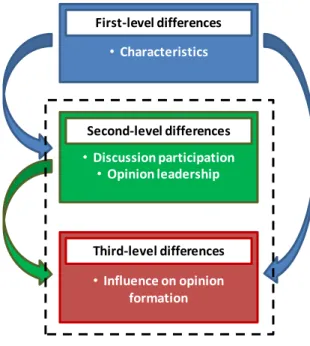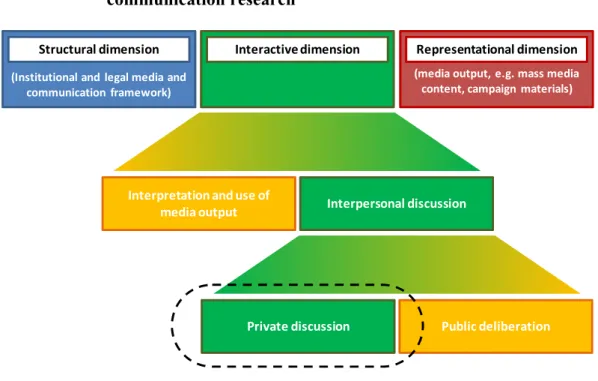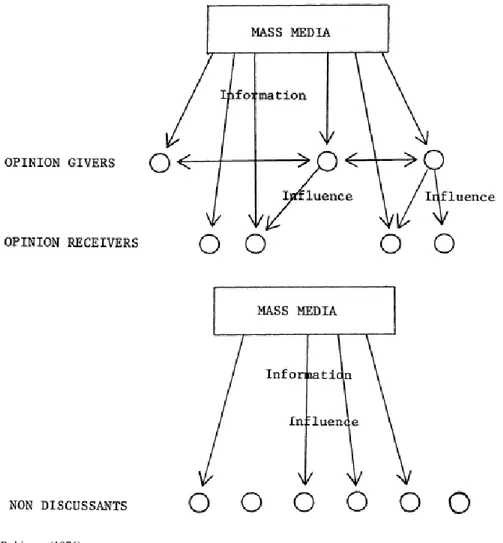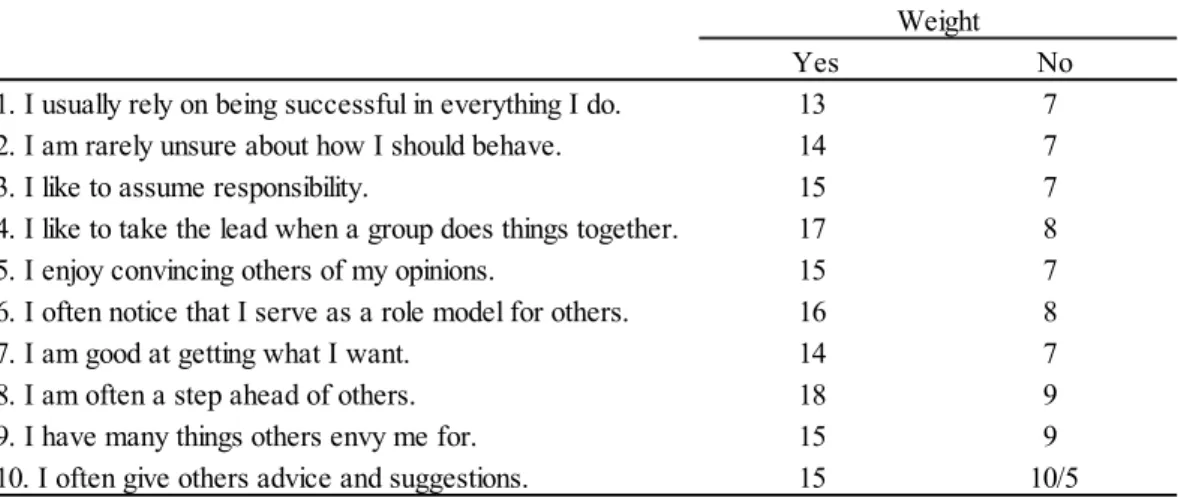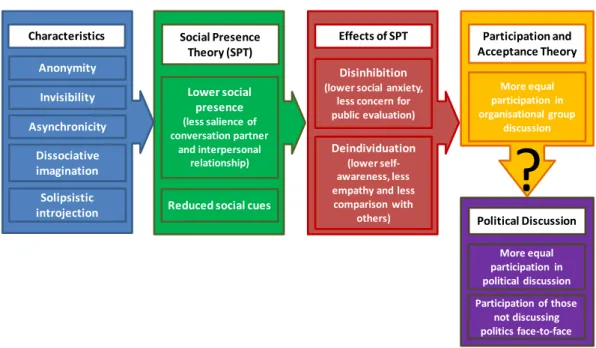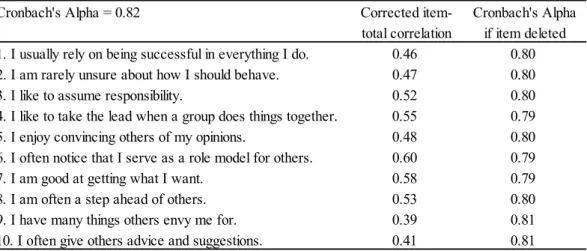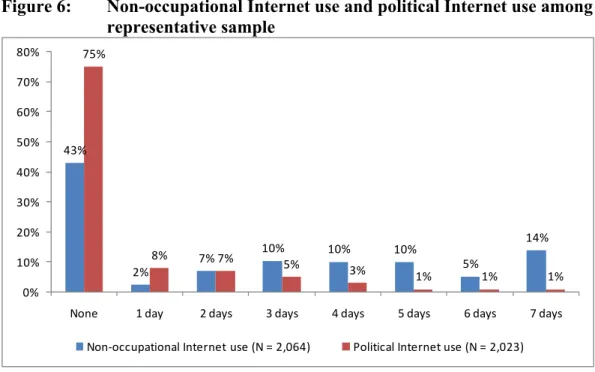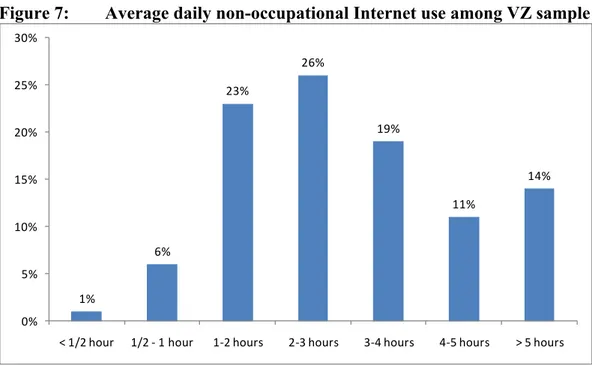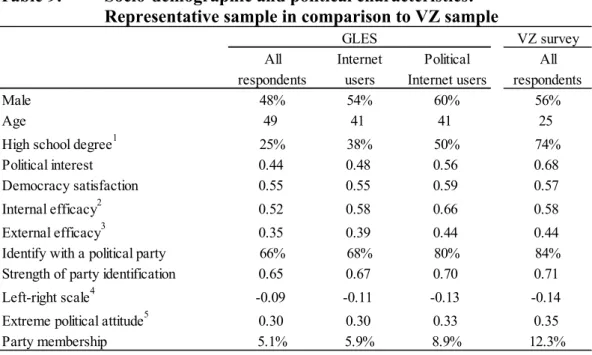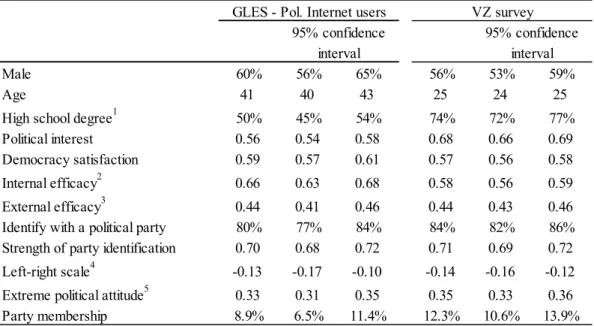Interpersonal communication and opinion leadership in the context of the
2009 German federal election
How the Internet raises the bar for most, but lowers it for some; and how ideas seem to flow from the Internet to the
general public via opinion leaders
A dissertation submitted to the faculty of Social and Economic Sciences at the Otto-Friedrich-Universität Bamberg in partial fulfilment of the requirements for
the degree of Dr. rer. Pol.
2011
2
Author: Max A. Odefey, MSc Phil
Supervisor and first reviewer: Prof. Dr. Harald Schoen Second reviewer: Prof. Dr. Thomas Saalfeld Third reviewer: Prof. Dr. Johannes Marx Datum der Abschlußprüfung: 26.04.2012
3 Abstract
This study investigates how political interpersonal communication and opinion leadership on the Internet differ from face-to-face interaction. Based on evidence from a survey conducted on the largest online social network in Germany at the time of the 2009 federal election, the characteristics, sources and perceived influence of those conversing about politics online and offline are juxtaposed.
The data reveals that, in aggregate, differences present in face-to-face discussions are amplified when people communicate online. Particularly those who are less active political discussants regard the Internet as a rather unpolitical medium.
Only very few people who refrain from influencing others face-to-face act as opinion leaders on the Internet. In fact, it seems that online opinion leadership is primarily a consequence of offline opinion leadership.
At the same time, the analysis shows that aggregate data pointing to a reinforcement of differences online is insufficient for refuting the mobilising power of the Internet. The small number of online discussants and online opinion leaders who are not active face-to-face are characterised by especially low levels of internal efficacy and political interest, suggesting that the Internet provides a space for political interaction for some of those who are less confident in political matters.
Finally, the results demonstrate that people consider face-to-face discussions to have a considerably higher impact on their political views than interpersonal communication on the Internet and that opinion leaders make disproportionately more use of campaign information on the Internet than non-leaders. Since opinion leaders probably draw on the political information they have gathered online
4
when they influence the views of others, Lazarsfeld et al.’s (1944) Two-Step Flow Model seems to play a role in the dissemination of online campaign information.
A noteworthy part of the campaign information available on the Internet probably reaches the general public via face-to-face conversations with opinion leaders.
And, as these discussions have such a crucial impact on people’s political views, the Internet’s influence on political opinion formation is likely to be more significant than suggested by the comparison of direct effects.
5 Contents
List of Figures ... 7
List of Tables ... 8
1 Introduction ... 9
2 Interpersonal communication ... 18
2.1 Within the context of political communication research ... 18
2.2 Public versus private interpersonal communication ... 19
2.3 Who participates in interpersonal communication? ... 23
2.4 Individual effects of interpersonal communication ... 26
2.5 Collective effects of interpersonal communication ... 30
2.5.1 Spiral of silence ... 31
2.5.2 Group polarisation ... 34
3 Opinion leadership ... 43
3.1 The Two-Step Flow Model ... 43
3.2 The concept of opinion leadership ... 52
3.3 Measuring opinion leadership ... 57
3.3.1 Key informant method ... 57
3.3.2 Socio-metric and network techniques ... 58
3.3.3 Self-designating method ... 61
3.3.4 Measurement of related concepts ... 62
3.4 Functions of opinion leaders ... 65
3.4.1 Relay function ... 66
3.4.2 Reinforcement function ... 68
3.5 Characteristics of opinion leaders ... 81
3.5.1 Socio-demographics ... 82
3.5.2 Social gregariousness ... 84
3.5.3 Political interest and knowledge ... 85
3.5.4 Political efficacy ... 87
3.5.5 Political extremity ... 89
3.6 Sources of opinion leaders ... 91
4 Computer-mediated communication ... 94
4.1 Computer-mediated interpersonal communication ... 94
6
4.1.1 Social Presence Theory ... 95
4.1.2 Criticism of Social Presence Theory ... 103
4.1.3 Social Network Theory ... 105
4.2 Computer-mediated opinion leadership ... 112
4.2.1 Domains of influence of opinion leaders ... 113
4.2.2 Characteristics of opinion leaders in different domains ... 115
4.2.3 Sources of opinion leaders in different domains ... 122
4.3 Perceived strength of computer-mediated influence ... 124
4.3.1 Influence relative to other sources ... 124
4.3.2 Differences between perceived and actual influence ... 128
5 Empirical analysis ... 136
5.1 Method ... 136
5.1.1 Survey ... 136
5.1.2 Measures ... 140
5.2 Results and discussion ... 147
5.2.1 Comparison to representative samples ... 148
5.2.2 Computer-mediated interpersonal communication ... 161
5.2.3 Computer-mediated opinion leadership ... 167
5.2.4 Perceived strength of computer-mediated influence ... 185
6 Conclusion ... 188
Appendices ... 203
Appendix A: Self-designating scales ... 203
Appendix B: Teaser page for VZ survey ... 205
Appendix C: Survey questionnaire ... 206
References ... 215
7
List of Figures
Figure 1: Differences between online and face-to-face communication analysed in this study ... 12 Figure 2: Focus of this study within the context of political communication
research ... 23 Figure 3: Robinson’s (1976) Multi-Step Flow Model ... 51 Figure 4: Trepte and Scherer’s (2005) typology of opinion leadership ... 87 Figure 5: Elements of Social Presence Theory applied to political discussion 102 Figure 6: Non-occupational Internet use and political Internet use among
representative sample ... 149 Figure 7: Average daily non-occupational Internet use among VZ sample ... 150 Figure 8: Second vote: Representative sample in comparison to VZ sample ... 157 Figure 9: Main source of campaign information: Representative sample in
comparison to VZ sample ... 158 Figure 10: Online campaign information seeking: VZ sample ... 159 Figure 11: Personality strength: Representative sample in comparison to VZ
sample ... 160 Figure 12: Satisfaction with democracy of opinion leaders and non-leaders ... 172 Figure 13: Online opinion leaders as a proportion of all respondents located in
each category along the left/right scale ... 174 Figure 14: Opinion leaders and non-leaders along the left/right scale ... 175 Figure 15: Main source of campaign information of opinion leaders and non-
leaders ... 181 Figure 16: Reading of political email of opinion leaders and non-leaders ... 184
8
List of Tables
Table 1: Noelle-Neumann’s (1983) personality strength scale: Items and
weighting ... 63
Table 2: Opinion leadership scale ... 140
Table 3: Political discussion and opinion seeking scales ... 143
Table 4: Reliability of the personality strength scale ... 144
Table 5: Scales measuring political attributes ... 145
Table 6: Internal efficacy scale ... 146
Table 7: External efficacy scale ... 146
Table 8: Scales measuring the parties’ problem-solving competence and the influence of different sources ... 147
Table 9: Socio-demographic and political characteristics: Representative sample in comparison to VZ sample ... 151
Table 10: Socio-demographic and political characteristics: Political Internet users among representative sample in comparison to VZ sample ... 154
Table 11: Confidence intervals around socio-demographic and political characteristics: Representative sample in comparison to VZ sample 155 Table 12: Political discussion activity of opinion leaders and non-leaders offline and online ... 163
Table 13: Domains of political discussion ... 164
Table 14: Characteristics of offline discussants and online discussants ... 164
Table 15: Characteristics of discussants and non-discussants ... 166
Table 16: Domains of political opinion leadership ... 168
Table 17: General characteristics of opinion leaders and non-leaders ... 169
Table 18: Political characteristics of opinion leaders and non-leaders ... 171
Table 19: Determinants of online opinion leadership ... 177
Table 20: Determinants of online opinion leadership including offline opinion leadership as a control variable ... 178
Table 21: Determinants of offline opinion leadership ... 179
Table 22: Characteristics of opinion leaders and non-leaders ... 180
Table 23: Sources of campaign information of opinion leaders and non-leaders ... ... 182
Table 24: Perceived strength of influence ... 186
9 1 Introduction
The uptake of electronic tools for the purpose of interpersonal communication has been staggering in recent years. Over the last three years, the percentage of German citizens communicating via online social networks has doubled and now stands at close to a third of the population. In 2010, 42 percent of Germans chatted with others online. This constitutes an almost two-fold increase since 2004. Also in 2010, email penetration among the German population reached 77 percent (De Sombre, 2010).
Unsurprisingly, many scholars are intrigued by the question of how interpersonal communication on the Internet differs from face-to-face interaction. Some of them have focused on what I call first-level differences: the disparities in attributes between the two modes of communication (e.g., Daft & Lengel, 1986; Dennis &
Valacich, 1999; Burgoon et al., 2000; for an overview see Kumar & Benbasat, 2002). These academics point out that face-to-face situations typically enable conversation pairs to respond to each other in a speedier fashion than is possible in an electronic environment. When people exchange emails, for example, feedback is not as immediate as when one interacts in person. What is more, most forms of computer-mediated communication limit the variety of signals that can be used. Gesture, mimic, posture, and other non-verbal cues cannot be employed in many kinds of online communication. In contrast to face-to-face communication, computer-mediated interaction can take place independent of time and space barriers. And, despite the significantly higher reach in terms of number of people, the cost of online communication is lower than that of in- person interaction (Lupia & Sin, 2003).
10
Another, somewhat more complex line of research examines the effects of the above disparities in characteristics on communication activity. While systematic analysis of these second-level differences is still lacking in the field of political science, a number of political scholars have discussed potential differences in discussion participation. One popular camp draws on the relative anonymity of online communication to suggest that the Internet motivates those to discuss politics who are too shy to do so in person. Shah, Cho, Eveland, Kwak, and Kwak (2005), for example, expect that many people find it easier to participate in political discussions and to share their personal views on the Internet. Similarly, Dahlgren (2005, p. 156) asserts that “the Internet seems to offer opportunities to participate for many people who otherwise find that there are too many taboos and too much discomfiture in talking about politics in their own face-to-face environments”. And, by encouraging those to talk about politics who remain passive offline, the Internet has an equalizing effect on discussion participation.
Such equalisation would be particularly significant, as many consider interpersonal political communication to be beneficial for the functioning of our democratic system. Citizens who discuss politics are more politically informed as well as more likely to vote and to engage in other forms of participation, which leads Kim, Wyatt, and Katz (1999, p. 362) to conclude that “conversation is the soul of democracy”. At present, the hypothesized equalisation of interpersonal communication is not sufficiently backed by evidence. Hence, this study will examine whether those who refrain from discussing politics with others face-to- face instead engage in interpersonal political communication on the Internet.
Dressler and Telle (2009) extend the notion of increased participation of the less active to the exercise of influence in interpersonal discussions about politics,
11
suggesting that the Internet may motivate those to influence the political opinions of others who refrain from doing so face-to-face. This issue may not be as central to the functioning of democracy, but it certainly is of great interest to those running political campaigns. Individuals who exert influence on the views of others are traditionally called opinion leaders. Political campaigners seek to provide these opinion leaders with suitable information and to mobilize them to spread the information within the electorate. Hence, political campaigners require a thorough understanding of the characteristics and sources of opinion leaders.
With this in mind, the present study will assess whether, as Dressler and Telle (2009) propose, there are indeed opinion leaders whose influence is confined to the online realm. Moreover, the attributes and information sources of opinion leaders on the Internet will be analysed in detail.
The examination of opinion leadership activity leads on to a third level of differences between communication on the Internet and face-to-face. This third level deals neither with the characteristics of communication nor with discussion participation but with the effect of interpersonal discussions on the citizens’
political opinions. In this respect, academics typically look at how the influence of communication on the Internet compares to that of face-to-face interaction. Some are convinced that online communication, because of its unique characteristics, has a more significant influence on people’s political opinions. Subramani and Rajagopalan (2003) assert that communication on the Internet, due to its reach, efficiency, and flexibility, is more persuasive than in-person interaction.
Similarly, Sun, Youn, Wu, and Kuntaraporn (2006) claim that online communication has a stronger effect on people’s views than face-to-face interaction, because of its pace and expediency. Given the lack of empirical
12
support for the above assertions, I will compare the strength of influence of online and offline communication on people’s political views. It is worth noting that this comparison will rely solely on people’s perception of influence rather than on measurement of actual influence.
Figure 1: Differences between online and face-to-face communication analysed in this study
• Characteristics First‐level differences
• Discussion participation•
• Opinion leadership Second‐level differences
•Influence on opinion formation Third‐level differences
The second and third-level differences between political communication online and face-to-face, which this study focuses on, are shown in Figure 1. In order to systematically assess these disparities the study is organized in three parts. The first two chapters explain in more detail why the selected problems merit careful consideration. The two subsequent sections examine the differences both theoretically and empirically. A final chapter concludes the study with a summary and a general appraisal of the results.
Section 2 scrutinizes whether an equalisation of the citizens’ participation in interpersonal political communication can be regarded as beneficial for our democratic culture. To begin with, interpersonal communication is put into the
13
wider context of political communication research. Based on Dahlgren’s (2005) break down of the public sphere, interpersonal communication is located within the interactive dimension of political communication. Section 2.2 defines private interpersonal communication, the main subject of this thesis, by contrasting it with public deliberation, another form of interpersonal communication. While public deliberation is a rule-governed form of interaction with the goal of making political decisions, private interpersonal communication describes the informal day-to-day conversations among citizens. Section 2.3 highlights the existing inequalities in participation in face-to-face communication about politics. Women as well as those with low levels of education, social gregariousness, and political interest are less prone to discussing politics with others. In order to assess if it would be advantageous to encourage the inactive to engage in interpersonal communication about politics, sections 2.4 and 2.5 provide a detailed account of the effects discussion participation can have on the citizenry and how these effects may be evaluated. Chapter 2.4 presents substantial empirical evidence showing how interpersonal communication enhances people’s political knowledge and the quality of their opinions. As discussions broaden the range of arguments people take into account when forming their political opinions and motivate people to reflect on their views, they are likely to have a positive impact on the quality of political decisions. The chapter also describes the work of several researchers illustrating the close association of political discussion activity and engagement in various forms of civic and political participation, a vital element of democratic self-government. The subsequent section sketches out two potential negative effects of interpersonal communication. According to Noelle-Neumann’s (1974)
“spiral of silence”, interpersonal discussion can lead to a silencing of minority
14
opinions and, thereby, create equality concerns. Secondly, since most political discussions take place between like-minded individuals, discussions tend to lead to a polarisation of opinions. Rather than ameliorating people’s understanding of different viewpoints, such conversations merely reinforce the status quo. But the section also explains why the applicability of the spiral of silence theory to interpersonal communication is highly questionable and that group polarisation is limited to discussions within homogeneous groups. While the majority of interpersonal discussions happen in homogeneous environments, many people discuss politics with those who hold divergent views. And, it is these heterogeneous interactions that are particularly valuable for the functioning of democracy. Considering these generally positive effects of interpersonal communication, it would be beneficial to encourage those individuals to participate who are currently less or not engaged. Before examining the Internet’s capacity to do so, however, the foundations need to be laid for the second subject of investigation: opinion leadership.
Section 3 not only defines the term opinion leadership as it is used in the present study but also explains why it is important for political campaigners to understand the attributes and behaviour of opinion leaders. A description of the research origins of the opinion leadership concept in section 3.1 serves as an introduction to the topic. In the 1940’s, Lazarsfeld and his colleagues were the first to suggest that some individuals influence the political views of others in their social environment by providing them with advice and relaying media information to them. Critics have pointed out that Lazarsfeld, Berelson, and Gaudet’s (1944) Two-Step Flow Model, which views opinion leaders as mediators between the media and the general public, needs to be seen in the context of various other
15
flows of information and influence. Based on the discussion of the Two-Step Flow Model, section 3.2 defines the term opinion leadership as it was conceived of by Lazarsfeld – the same conception that is used in the present study. For Lazarsfeld et al. (1944), opinion leadership is a behavioural variable describing the informal exertion of influence on others in a specific field of interest. When comparing different studies, it is important to clearly distinguish between this and other conceptions of opinion leadership, which define opinion leadership as a general character trait or by the level of engagement in political participation.
Similarly, one needs to be cognisant of differences in measurement which may impact the quality and comparability of empirical data. Hence, section 3.3 contrasts the self-designating method employed in the present study with alternative approaches. Following these methodological distinctions, section 3.4 provides a detailed account of the role of opinion leaders in individual political opinion formation. It is illustrated that most media information flows directly from the media to the general public, but that opinion leaders have considerable influence on the subsequent evaluation of the received information. Three theories of social influence are described to explain the reasons non-leaders have to conform to the views of opinion leaders and why opinion leaders may be motivated to exercise influence. Non-leaders may follow the advice of opinion leaders in order to reduce the cost of information search and assessment, to be associated with the social group embodied by the opinion leader, or to attain social support. Opinion leaders, on the other hand, may give advice in order to attain a position of superiority and to legitimize their own viewpoints. Given the solid theoretical and empirical foundation of the opinion leaders’ influence function, it is easy to see why political campaigners are greatly interested in the
16
characteristics and information sources of opinion leaders. Prior to assessing these attributes of opinion leaders on the Internet, however, the existing research on opinion leadership in face-to-face situations needs to be examined. These findings from previous studies, which are presented in sections 3.5 and 3.6, serve as a useful point of reference for the analysis of online opinion leaders.
Section 4 presents a theoretical analysis of interpersonal communication and opinion leadership on the Internet. Section 4.1 assesses the Internet’s impact on discussion participation by drawing on two established theories about computer- mediated communication. Applying Social Presence Theory to interpersonal communication about politics provides support for the equalisation hypothesis.
The theory suggests that those who are too shy and too introverted to discuss politics face-to-face express themselves with an increased forthrightness on the Internet. In contrast, the application of Social Network Theory to interpersonal political communication indicates that the Internet supplements and extends face- to-face behaviour rather than changes the nature of discussion relationships. It is illustrated that the two theoretical concepts also point to different answers to the question whether there is a meaningful group of opinion leaders who exercise influence solely online. Few studies to date have examined political opinion leaders on the Internet. Therefore, research on marketing opinion leaders and on concepts similar to political opinion leadership are employed to derive hypotheses about the characteristics and political information sources of online political opinion leaders (see sections 4.2.2 and 4.2.3). These related studies suggest that offline opinion leaders and online opinion leaders share similar characteristics and rely more than non-leaders on the Internet for obtaining political information. A similar approach is used in section 4.3.1 to develop hypotheses regarding the third
17
major field of investigation, the comparison of the perceived influence of different sources on people’s political opinions. Based on Social Presence Theory as well as findings from the realm of marketing, I propose that online communication is less impactful than face-to-face interaction. Before the hypotheses are tested, however, section 5.1 describes the sample and methodology used. Detail is provided on the VZ networks, the online social network on which the data for the present study was collected. Following a comparison between the VZ sample and representative surveys, the results of the empirical analysis are presented in section 5.2.
18 2 Interpersonal communication
2.1 Within the context of political communication research
Habermas’ (1962) concept of the public sphere is one of the key reference points for political communication theory and research, as it provides a useful framework for the academic debate about politics, interpersonal discussion, and the media. The public sphere entails the spaces, independent of the economy and the state, in which citizens get together to deliberate and exchange ideas about current political affairs (Calhoun, 1992). Within such spaces the media and interpersonal discussions shape political opinions.
According to Habermas (1962), the public sphere developed for the first time in the salons of late-eighteenth-century France as a counterbalance to the state and sought to make public policy more accountable to the citizens (Fraser, 1990).
Spreading literacy, the rise of mass media, the ascent of the middle class, and growing importance of democratic institutions contributed to the development of the public sphere. The enactment of individual rights guaranteeing freedom of expression, free press, and free assembly also played a crucial role in the process (Kinder, 1998).
Dahlgren (2005) differentiates between three dimensions of political communication that together comprise the public sphere. The structural dimension includes all formal institutional elements of the media and the laws protecting the freedom of communication. At the heart of this perspective lies the requirement that the institutions of the public sphere must be accessible to all citizens. Hence, media ownership, regulation, media policy and economics, as well as the rules of
19
access are important components of the structural dimension. The representational dimension captures the content produced by the various types of one-to-many media – the mass media as well as more specific publications such as newsletters and campaign materials. The most critical representational issues include fairness, truthfulness and comprehensiveness, diversity of viewpoints, balanced presentation, and ideological tolerance. The structural and representational dimensions provide the framework for the interactive dimension. On the one hand, the interactive dimension includes the citizens’ interpretation and use of media content, the process through which individuals receive and utilize what has been communicated to them by the media. On the other hand, the interactive dimension entails the citizens’ discussions about political issues. It is these interpersonal discussions that the next section will focus on.
2.2 Public versus private interpersonal communication
The academic dialogue about interpersonal communication has been complicated by the use of different conceptions of political talk. The spectrum of definitions ranges from casual, informal interaction to rule-governed, structured encounters (Wyatt, Katz, & Kim, 2000). The former are typically referred to as private interpersonal communication, the later as public interpersonal communication.
Tarde’s ([1899] 1989) notion of conversation about political events among people sitting in coffee houses is a classical example of the private kind. In contrast, public interpersonal communication typically refers to debates within a formal context such as a civic forum.
Public interpersonal communication usually denotes the process of public deliberation, in which informed citizens exchange rational arguments on a given
20
policy issue (Scheufele, 2000). Deliberation is an inclusive problem-solving process that provides citizens with the opportunity to acquire meaningful political judgements. It is characterized by non-dominance, logical argumentation, and reciprocal comprehension. After individual viewpoints have been voiced and assessed, the goal is to resolve conflicts and to converge on a mutually acceptable solution. Deliberation seeks to provide people with new arguments which lead them to revise their attitudes and arrive at well-informed views (Moy & Gastil, 2006). According to Chambers (2003), deliberation does not necessarily aim at consensus, as citizens are free to pursue their own interests. Nonetheless, citizens involved in deliberation are committed to justifying decisions to the other discussants.
Procedurally, deliberation typically requires careful problem analysis, specification of evaluation criteria, and weighing of alternative solutions (Dewey, 1954). Coleman and Gøtze (2001, p. 6) list a number of conditions of ideal public interpersonal communication, namely “access to balanced information”, “an open agenda”, “time to consider issues expansively”, “freedom from manipulation or coercion”, “a rule-based framework for discussion”, “participation by an inclusive sample of citizens”, “scope for free interaction between participants”, and
“recognition of differences between participants, but rejection of status-based prejudice”.
Schudson (1997) is probably the most vocal proponent of the importance of public interpersonal communication. He believes that informal discussions among intimates happen only for their own sake and do not provide benefits to society. In his view, political discussion is inherently complicated and conflict-ridden, which is why rules are required to guide the interaction. To be beneficial, political
21
conversations need to follow a set agenda and need to be oriented towards making decisions. Political discussions need to be a problem-solving process among people from different backgrounds rather than simply a sociable exchange among like-minded individuals. Only through public deliberation will people develop sensible judgements and will sound government become possible (Kim et al., 1999).
Although few are as pessimistic as Schudson (1997) about private interpersonal communication, numerous other scholars are convinced that public deliberation creates certain benefits. Gutmann and Thompson (1996) point to the positive effect on tolerance for other people’s views. Chambers (1996) believes that deliberation enhances the citizens’ understanding of and ability to justify their preferences. Fishkin (1995) anticipates an increase in social capital. Deliberation fosters communication networks and enhances political expertise enabling citizens to engage more effectively in community affairs. Overall, the equal and open exchange of arguments inherent in deliberation is bound to promote empathy among citizens (Mendelberg, 2002).
Despite these potential advantages, public deliberation has limited practical relevance. In reality, it is often not possible to include all the individuals affected by a policy decision in the deliberative process. The introduction of online rule- based public forums has raised hopes of enabling public deliberation on a large scale. But even online public forums are hard to scale up and usually reach only a core group of activists (Kavanaugh et al., 2006). For effective deliberation to take place, the number of participants needs to be restricted. Dahlberg’s (2001) analysis reveals that online deliberation projects fail to activate representative samples of citizens and shows problems in attracting participation. The inability
22
to incorporate all affected views creates inequality concerns (Ryfe, 2005).
Furthermore, many people are unwilling to participate in public deliberation due to doubts about their argumentative abilities and fear of being isolated in the discussion. As public interpersonal communication is rather demanding, it has been limited to a small number of highly politically active citizens (Schmitt-Beck, 2008).
Private interpersonal communication, in contrast, is more personally satisfying, because discussants are less exposed than in public deliberation (Conover, Searing, & Crewe, 2002). An experiment conducted by Wyatt, Katz, Levinsohn, and Al-Haj (1996) shows that people are more willing to speak up in private settings than they are in public deliberation. Since opinion expression is less inhibited by social factors, private interpersonal communication seems particularly powerful.
What is more, private interpersonal communication is a much more common form of interaction. Private interpersonal communication is often spontaneous and melds together with everyday conversations about issues other than politics (Wyatt et al., 2000). Many people talk about politics with family members, with friends, and with colleagues at work. In several Western European and North American countries, as much as 40 percent of citizens report to discuss political issues several days a week or every day. Germany has one of the highest rates of political discussion activity with 47 percent talking about politics with high frequency (Schmitt-Beck, 2008). It is this prevalent form of interaction, private interpersonal communication, that constitutes this study’s principal subject of investigation (see Figure 2).
23
Figure 2: Focus of this study within the context of political communication research
(Institutional and legal media and communication framework)
Structural dimension Interactive dimension
(media output, e.g. mass media content, campaign materials) Representational dimension
Interpretation and use of
media output Interpersonal discussion
Private discussion Public deliberation
2.3 Who participates in interpersonal communication?
While private discussion activity in Germany is high by international standards, the figures indicate that not everyone participates in political discussions to a similar extent. In fact, research shows that certain individuals are less likely than others to engage in interpersonal communication about politics. Women are less prone to discuss politics than man. Those who are less well-educated, less socially integrated, and less politically interested are also less disposed to communicate about politics.
Gender and the level of education are considered to be the most important socio- demographic determinants of private interpersonal political communication. A number of studies show that males are more prone to discuss politics (e.g., Brickell, Huckfeldt, & Sprague, 1995; Bennett et al., 2000). Kornelius and Roth (2004) differentiate between political discussions at home and political talk with
24
friends and acquaintances. A study they conducted in Germany in 2003 reveals that men and women discuss politics to a similar extent at home, but that women are significantly less likely to have conversations about political matters with their friends. According to Kornelius and Roth (2004), educational differences are even more pronounced than gender disparities, however. Those holding a high school degree, the German Abitur, are not only substantially more likely to talk about politics with their friends but also converse more frequently with other family members. Several other researchers confirm that education is linked to interpersonal political interaction (La Due Lake & Huckfeldt, 1998). As Verba, Schlozman, and Brady (1995) point out, those with insufficient education often lack the skills necessary to contribute to political discussion. Well-educated individuals are typically better at absorbing intricate political information (Rosenberg, 1988). The lower one’s education level, the higher is the cost of participating in political interaction, reducing the incentive to contribute (Downs, 1957). La Due Lake and Huckfeldt (1998), who find a statistically relevant relationship between education and frequency of political discussion, assert:
“Education creates the human capital resources that lead to effortless engagement within the political system” (p. 568).
Unsurprisingly, those who are not well-integrated within their social environment are also less prone to converse about politics with others. Kornelius and Roth (2004) illustrate that those engaged in volunteer organisations are significantly more prone to discuss politics with friends and family members. Leighley (1990) points out that the likelihood of being exposed to politically active citizens increases with the size of an individual’s social network. Social integration is usually accompanied by higher levels of trust and engagement in community
25
organisations, both of which are associated with participation in political discussions (Price & Cappella, 2002). Members of civic organisations and voluntary associations have ample opportunity to meet people, to discuss social and political issues with them, and to develop additional social relationships (Verba et al., 1995). Stamm, Emig, and Hesse (1997) regard interpersonal communication as the principal mechanism of community integration.
Political interest can be seen as the motivational basis for interpersonal communication activity. Huckfeldt, Ikeda, and Pappi (2000) assert that a person’s level of political interest is possibly the best predictor of political discussion activity. Similarly, Beck (1991) stresses the importance of political attentiveness, as measured by attention to election campaigns, concern about election outcome, and level of political information. He finds a significant positive correlation between political attentiveness and exchange with personal sources. Bennett et al.
(2000) confirm that psychological involvement in public affairs, measured by attention to the election as well as general interest in politics, is a potent determinant of political discussion.
In summary, some citizens are less likely than others to engage in private discussions about political matters. A low level of education hampers a person’s participation in interpersonal communication about politics. If a person’s social network does not provide sufficient opportunities for interaction, engagement in political discussions is unlikely. Those who are less interested and less involved in the subject matter naturally are less motivated to discuss public policy issues.
26
2.4 Individual effects of interpersonal communication
These inequalities in discussion participation raise the question whether it would be desirable to motivate those who are currently less active or inactive to talk about politics. Many academics claim that interpersonal communication about politics is beneficial for the health of a democracy. Most of them, however, do not articulate the criteria they use for judging whether a given effect is positive. In my view, clear valuation standards are a precondition for the proper assessment of outcomes. Hence, before evaluating the effects of private interpersonal communication on our democratic system, I will outline the valuation standard applied in this study.
Aristotle (6.1317b) describes democracy as the “government of each by all, and of all by each” in accordance with the principles of equality and liberty. To him democracy is intrinsically valuable, because its procedures treat citizens as free and equal and facilitate self-government. Others see the value of democracy in its ability to bring about the best outcomes. Arneson (2003, p. 122), for example, asserts that “what renders the democratic form of government for a nation morally legitimate (when it is) is that its operation over time produces better consequences for people than any feasible alternative mode of governance”. For the purpose of this analysis, I see no need to debate the relative merits of procedural and consequential arguments. Instead, I take it for granted that there is both intrinsic value in the free and equal rule of the people and instrumental value in its good outcomes. Hence, I will evaluate the effects of interpersonal communication based on whether such communication advances or hinders the citizens’ ability to govern themselves and on whether it can be expected to improve or worsen the quality of the outcomes of the democratic process. Both of these are ultimately
27
subjective matters, but unfortunately political philosophy does not provide us with an objective set of criteria.
With this yardstick in mind, let us turn to the assessment of the effects of private political discussions. Many scholars point to the capacity of interpersonal communication to render citizens more knowledgeable about politics. Sietman (2005) highlights that private discussions, unlike public ones, do not always entail logical argumentation. Nonetheless, she stresses that private discussions increase the quality of people’s opinions and their comprehension of political questions. A study conducted by Moy and Gastil (2006) illustrates that informal discussion among citizens is significantly associated with political know-how. Bennett, Flickinger, and Rhine (2000) studied empirical evidence over the last 30 years and found the relationship between political knowledge and discussion to be stable across the time period. Schmitt-Beck (2000) reveals positive correlations between the intensity of discussion activity across a range of different types of discussion relationships and political involvement among West-German citizens. De Vreese and Boomgaarden (2006) emphasize the relationship between private interpersonal communication and political sophistication. Discussion engagement enhances people’s capability and motivation to gain a deeper understanding of political issues (cf. Finkel, 1985).
It is Wyatt et al. (2000) who establish a significant correlation between political conversation and “consideredness”, a more specific measure of competence based on the quality of the reasons a respondent quotes for holding certain political views. Similarly, Price and Cappella (2002) find that interpersonal communication extends the range of arguments taken into account when forming one’s opinion. And, they point out that the enlarged repertoire of arguments
28
produces political views of higher quality. Price, Nir, and Cappella (2006) show that not only face-to-face discussants but also those who engage in political discussions on the Internet score higher on “argument repertoires” scales.
Kim et al. (1999) establish a relationship between political discussion activity and the clarity, consistency, and ideological coherence of a person’s arguments. It is often only when people have a chance to discuss their views with others that they realize their conflicting nature. Expressing their opinions vocally makes it easier to organize them in a coherent way. Scheufele (2001) even suggests that interpersonal political communication is a necessary condition for fully grasping political issues and for incorporating them into one’s existing knowledge.
While one may not agree that it is a necessary condition, the above studies illustrate that political talk is associated with an improved understanding of political matters and of the different views individuals may hold. Since the citizenry has the power to elect politicians who govern in a way the citizens deem appropriate, one would expect enhanced political knowledge among the electorate to have an indirect positive impact on the quality of the outcomes of the democratic system. And, even if one doubts this indirect instrumental benefit, it is hard to deny that a more politically savvy citizenry is better able to realize its right of self-government.
More fundamentally, political discussions advance the realization of this right by connecting individual citizens with political life. As Bryce ([1888] 1973) pointed out many decades ago, it is this connection that constitutes one of the most crucial functions of private political talk. Citizens incorporate the information they receive from the political realm into private conversations. These private conversations shape their opinions, voting decisions, and participatory behaviour.
29
All of these factors, in turn, impact the political domain. Because of this connecting function, private interpersonal communication can be seen as a prerequisite of informed self-government (cf. Wyatt et al., 2000).
Finally, it is worth examining the relationship between political discussion activity and political participation, because political participation is probably the most direct form of the citizens’ self-government in today’s democracies. Böhnke (2011) puts it bluntly: “When people say democracy they mean political participation” (p. 18, translated from German).
Many academics have shown that political talk promotes political participation (De Vreese & Boomgaarden, 2006). Kornelius and Roth (2004) illustrate that those regularly engaged in political discussions with friends and family are more likely to vote. Schenk (1982) reveals a correlation between political conversation activity and engagement in citizens’ initiatives in Germany. La Due Lake and Huckfeldt (1998) establish a positive relationship between political discussion frequency and a number of traditional forms of political participation:
Campaigning for a candidate or party, being present at candidate or party rallies, putting signs, buttons or bumper stickers on show, donating money, and voting.
La Due Lake and Huckfeldt (1998) make reference to Putnam’s (1995) idea of social capital. They argue that “social capital is realized through networks of political communication, thereby enhancing the likelihood that individuals will become politically engaged” (p. 569). McLeod, Scheufele, and Moy (1999) examine two forms of participation. Institutionalized participation includes voting and contacting government officials. Non-traditional participation is measured by one’s willingness to partake in and to speak up at civic forums on an important social or political issue. Public forums enable citizens to discuss their views on a
30
given subject with government officials as well as with other citizens. McLeod et al.’s (1999) analysis establishes statistically relevant relationships between talk and each form of participation. Moy and Gastil (2006) also find evidence for a link between interpersonal political talk and both partaking is public forums and sustained campaign involvement. Overall, there is strong evidence for the relationship between political discussion and various forms of political participation.
2.5 Collective effects of interpersonal communication
Schudson’s (1997) comments outlined in section 2.2 illustrate that not everyone regards private political discussions as beneficial for democratic societies. Among the potential drawbacks of interpersonal communication, two aggregate level effects have received considerable attention among scholars. Firstly, Noelle- Neumann’s (1974) spiral of silence suggests that private political discussions may contribute to a silencing of the minority. Such an effect could be considered to violate the equality principle at the heart of self-government. Secondly, group polarisation theory holds that interpersonal communication within homogeneous groups tends to amplify prevailing individual opinions. And, because most interpersonal communication takes place within homogeneous environments, these discussions more often than not enforce the status quo. It is difficult to judge the impact of group polarisation on the functioning of democracy. Intuitively, it seems that the resulting bias in favour of the prevailing political view within the social group is more likely to impair than to enhance the quality of the output of the political system. At the same time, individuals with more firmly held political
31
opinions are more prone to vote, an essential part of the citizens’ self-government (Binder, Dalrymple, Brossard, & Scheufele, 2009).
2.5.1 Spiral of silence
According to Price et al. (2006), the most renowned theory of collective social influence effects is Noelle-Neumann’s (1974) spiral of silence, which is based on conformity research, most prominently that of Asch (1956). Noelle-Neumann (1974) postulates that the “climate of opinion” conveyed by the media and through personal conversations influences people’s willingness to voice their views. Those who see themselves as belonging to the majority are more prepared to speak up. In contrast, those who perceive their views to be contrary to the majority opinion are less eager to voice them. In a spiral of silence, the disproportionate communication activity of the majority shifts the perceived public opinion further in the majority’s favour. As minorities refrain from voicing their opinion, the majority view becomes yet stronger.
It is worth highlighting that the silencing of the minority is driven as much by the current perceived climate of opinion as by the expected changes in public opinion.
Those who recognize their viewpoint as gaining traction are more likely to be eager to engage in political discussions, whereas those who see support for their opinion on a political issue fading are less likely to plan to voice their view (Binder, et al., 2009). The desire not to become isolated is stronger than the wish to stand up for one’s own judgements (Noelle-Neumann, 1977).
Noelle-Neumann’s (1974) theory has many facets, some of which do not deal with social influence but focus on media effects. Noelle-Neumann’s (1974) initial research shows, for example, how biased media coverage that misrepresents the
32
prevailing majority opinion can trigger a shift in public opinion. While the theory’s contribution to the study of media effects on public opinion formation is remarkable, I will focus on the spiral of silence’s conclusions with regards to personal opinion expression. According to Noelle-Neumann (1974), the relationship between personal opinion expression and perceived public opinion is reciprocal. Interpersonal discussions contribute to the perceived climate of opinion. In turn, the climate of opinion influences people’s willingness to speak up. Hence, the social effect of interpersonal discussions is that they indirectly contribute to the silencing of the minority. As it is difficult to test the first element of the relationship, namely the influence personal opinion expression has on the perceived climate of opinion, research has concentrated on the second element.
Most academics interested in the social effects postulated by the theory investigate whether the perceived majority opinion influences people’s willingness to voice their views. If this link would be refuted, this would at the same time disprove the supposed indirect effect.
Empirical results regarding this connection are mixed. Taylor (1982) found that perceived public support is related to willingness to express one’s opinion for those that are part of the majority. In contrast, Katz and Baldassare (1992) who analysed respondents’ readiness to speak to a reporter on a given issue found no proof for the spiral of silence. A meta-analysis of numerous survey studies conducted by Glynn, Hayes, and Shanahan (1997, p. 452) concludes that there is a
“very small, but statistically significant, relationship between the degree to which a person believes others hold similar opinions and the willingness to express those opinions”. 19 out of the 25 analysed studies established a correlation between willingness to speak up and perception of prevailing public opinion. The impact
